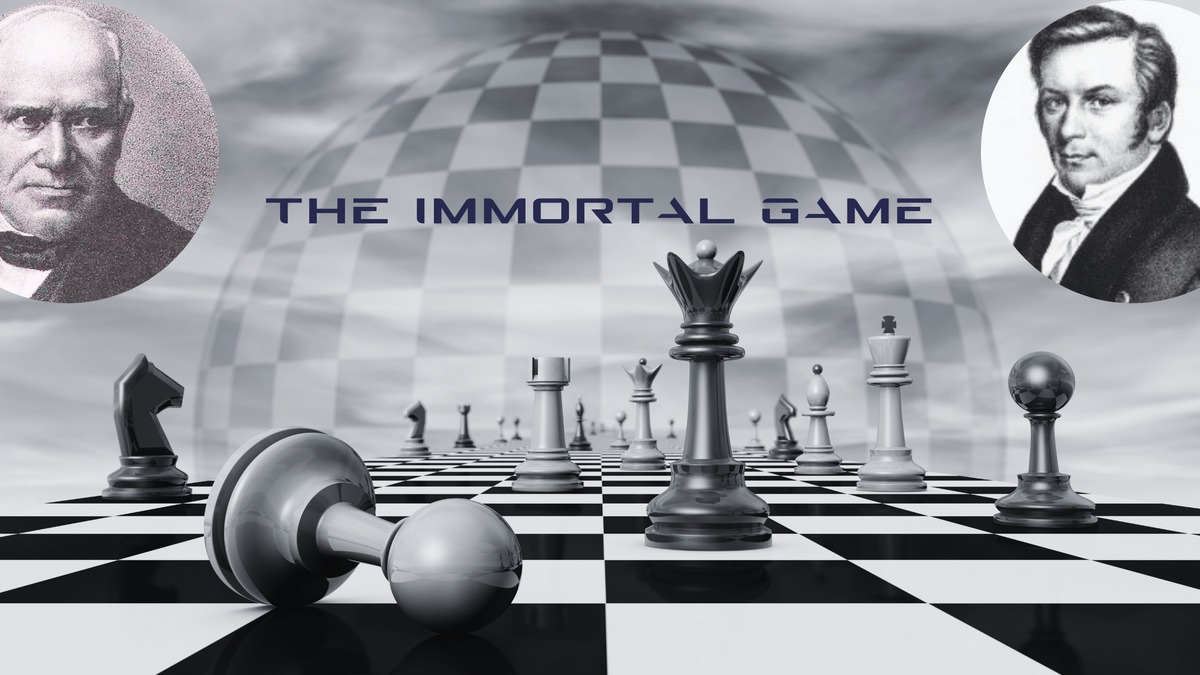The Immortal Chess Game: A Timeless Battle of Brilliance

Chess, the ancient game of strategy and intellect, has produced countless memorable games throughout history. But among the vast sea of games, there exists a special category of encounters that transcends time and space—the Immortal Chess Games. These extraordinary battles are etched into the annals of chess history, celebrated for their unparalleled beauty, creativity, and sheer brilliance. Here, we embark on a journey through one such game, a masterpiece that has captivated chess enthusiasts for generations.
The Immortal Chess Game:
The Immortal Chess Game we delve into today is the match between Adolf Anderssen and Lionel Kieseritzky, played on June 21, 1851, in London. This historic encounter is widely regarded as one of the greatest games ever played, a symphony of tactics and sacrifices that continues to inspire chess players to this day.
The Opening Moves: Anderssen, playing White, opened with 1.e4, to which Kieseritzky responded with the French Defense, 1...e5. The game quickly took an adventurous turn when Anderssen sacrificed his knight on move 11, revealing his intent to create a tactical masterpiece.
The Bishop Sacrifice: On move 17, Anderssen stunned his opponent with a breathtaking bishop sacrifice—17.Bxf7+! The move exposed Black's king, forcing it into a precarious position and putting tremendous pressure on Kieseritzky's defensive skills.
The Queen Sacrifice: Not to be outdone, Kieseritzky retaliated with a remarkable queen sacrifice on move 20—20...Qxf2+! This audacious move shattered White's king-side defenses and opened up a pandora's box of possibilities.
The March of the Rooks: Anderssen unleashed his rooks with deadly precision, utilizing them to wreak havoc on Kieseritzky's exposed king. The rooks danced across the board, executing elegant maneuvers and devastating tactics that left the chess world in awe.
The Final Blow: As the game reached its climax, Anderssen delivered the decisive blow—24.Ng6+! A stunning knight sacrifice that sealed his victory. With this move, Anderssen cleared the path for his remaining pieces to deliver a checkmate that will forever echo through chess history.
Legacy and Influence:
The Immortal Chess Game between Anderssen and Kieseritzky transcends its historical context, serving as a testament to the boundless potential of the human mind. Its intricate tactical brilliance and daring sacrifices have made it an everlasting source of inspiration for chess players, from novices to grandmasters.
Educational Value: The Immortal Chess Game offers valuable lessons in chess strategy, pattern recognition, and the art of sacrifices. It teaches us about the power of imagination, the importance of calculation, and the ability to visualize multiple moves ahead.
Aesthetics and Beauty: This legendary game showcases the artistic side of chess, revealing its capacity to be a sublime and beautiful art form. From the cascading sacrifices to the harmonious coordination of the pieces, the game captivates us with its sheer elegance and aesthetic appeal.
Strategic Creativity: The Immortal Chess Game serves as a reminder that creativity knows no bounds within the 64 squares. It inspires players to think outside the box, explore uncharted territory, and unleash their inner innovator to create their own masterpieces.
The Immortal Game between Adolf Anderssen and Lionel Kieseritzky holds great significance in modern chess as it is regarded as one of the most brilliant and iconic examples of tactical play and sacrificial chess. Despite being played in 1851, the game continues to inspire and captivate chess players and enthusiasts today. Here are some reasons why it remains significant in modern chess:
- Tactical Brilliance: The game is renowned for its series of daring sacrifices and tactical fireworks. Anderssen sacrificed multiple pieces, including his queen, rooks, and bishop, to deliver a checkmate against Kieseritzky's king. The game showcases exceptional calculation, imagination, and a deep understanding of tactical possibilities, which are still highly valued skills in modern chess.
- Romantic Era Influence: The Immortal Game represents the Romantic Era of chess, a period from the mid-19th to mid-20th century characterized by highly imaginative and aggressive play. It epitomizes the spirit of the era, where players emphasized daring attacks and sacrifices over solid positional play. Although modern chess has become more strategic and positionally oriented, the game reminds players of the vibrant and dynamic nature of the game's history.
- Sacrificial Play: The game highlights the power and effectiveness of well-calculated sacrifices. Anderssen's sacrifices aimed to disrupt Kieseritzky's defenses, expose weaknesses, and launch a devastating attack. It serves as a reminder to modern players that sacrificing material for positional or tactical advantages can be a potent weapon, challenging opponents and creating imbalances on the board.
- Chess Combinations and Tactics: The Immortal Game provides a wealth of instructive chess combinations and tactics. Players can study the game to enhance their tactical awareness, pattern recognition, and ability to spot winning combinations. The imaginative and unexpected moves throughout the game demonstrate the importance of considering all possibilities and exploring creative solutions in complex positions.
- Historical Significance: The game's historical significance lies in its lasting impact on the chess community. The Immortal Game has been celebrated and studied by generations of chess players, and it continues to be referenced and analyzed in chess literature, articles, and educational materials. Its enduring popularity showcases the game's ability to transcend time and inspire future generations of chess players.
While modern chess has evolved with the introduction of advanced computer analysis and a greater emphasis on positional understanding, the Immortal Game remains a symbol of the rich heritage and artistic beauty of chess. It serves as a reminder of the importance of creativity, intuition, and tactical brilliance in the pursuit of victory on the chessboard.
The Immortal Chess Game between Anderssen and Kieseritzky stands as a beacon of brilliance and creativity in the chess world. Its intricate maneuvers, audacious sacrifices, and breathtaking checkmate have solidified its place in chess history as one of the most memorable encounters ever played.
As chess enthusiasts, let us celebrate and learn from this immortal masterpiece, seeking to infuse our own games with the same spirit of ingenuity and excellence. The beauty and endless possibilities of chess continue to evolve, with each generation adding its own chapter to the timeless saga of the game.
Move-by-move description
Here's a move-by-move description of the Immortal Chess Game between Adolf Anderssen and Lionel Kieseritzky:
- e4 e5 The game begins with the popular opening moves of 1.e4 from Anderssen and a symmetrical response of 1...e5 from Kieseritzky. Both players aim to establish control in the center of the board.
- f4 Anderssen chooses the King's Gambit, offering a pawn in exchange for rapid development and an aggressive position.
2...exf4 Kieseritzky accepts the gambit, capturing the pawn on f4.
- Nf3 g5 Kieseritzky counters with a pawn advance, intending to solidify his position and stake claim to the center.
- h4 g4 Anderssen pushes forward with another pawn move, opening up lines and intensifying the battle.
- Ng5 Anderssen develops his knight to g5, eyeing the vulnerable f7 square in Black's camp.
5...h6 Kieseritzky challenges the knight by attacking it with his pawn on h6.
- Nxf7 Anderssen initiates a surprising knight sacrifice, capturing Black's pawn on f7.
6...Kxf7 Kieseritzky accepts the knight sacrifice, seizing the opportunity to develop his king and gain material advantage.
- Qxg4 Anderssen unleashes his queen, threatening to deliver checkmate on h5.
7...Qf6 Kieseritzky defends his king by moving his queen, while still eyeing the f4 square.
- Bc4+ Anderssen develops his bishop with a check, increasing the pressure on Black's position.
8...Ke7 Kieseritzky moves his king to e7, seeking shelter in the center.
- Nc3 Anderssen continues to develop his pieces, bringing his knight into the game and preparing for an attack.
9...Kd8 Kieseritzky protects his knight on f6 by moving his king to d8.
- Nd5 Anderssen further intensifies the attack by developing his other knight and eyeing the c7 square.
10...Qg7 Kieseritzky defends against the potential threat of a discovered check on his queen.
- Qxf4 Anderssen continues his aggressive play, attacking Black's king and preparing for potential sacrifices.
11...Bd6 Kieseritzky counters by developing his bishop and pinning Anderssen's knight.
- Qf3 Anderssen retreats his queen, maintaining the tension in the center and preparing for future maneuvers.
12...Nc6 Kieseritzky develops his knight, aiming to reinforce his defense and counterattack.
- O-O Ne5 Kieseritzky's knight infiltrates White's position, targeting Anderssen's vulnerable pieces.
- Qe2 Qg3 Kieseritzky launches a powerful attack by threatening a checkmate on g2.
- d4 Anderssen counters by advancing his d-pawn, sacrificing another pawn to open up lines and create tactical opportunities.
15...Ng4 Kieseritzky continues his aggressive play, aiming to exploit the weaknesses in White's position.
- Bf4 Bxf4 Anderssen sacrifices his bishop, forcing Kieseritzky to recapture and opening up lines for his rooks.
- Rxf4 Qh2+ Anderssen's rook on f1 is under attack, but he calmly moves his king to safety.
- Kf1 Qxf4+ Kieseritzky initiates a surprising queen sacrifice, aiming to expose White's king and launch a counterattack.
- Nxf4 Ne3+ Kieseritzky's knight checks the white king, further complicating the position.
- Kg1 Nxc4 Anderssen accepts the sacrifice and captures Kieseritzky's knight, materializing his advantage.
- Rf1 Nd6 Anderssen consolidates his position by developing his knight and centralizing his forces.
- Ng6 Re8 Kieseritzky defends against the threat of a discovered check by moving his rook to e8.
- e5 Anderssen advances his e-pawn, creating threats and preparing to open lines against Black's king.
23...Ne4 Kieseritzky's knight seeks refuge on e4, defending key squares and coordinating with his other pieces.
- Ng6+! Anderssen delivers a stunning knight sacrifice, clearing the path for a decisive checkmate.
24...Nxg6 Kieseritzky is forced to capture the knight with his king, as moving his rook would result in a checkmate.
- Rf6 Re6 Kieseritzky tries to defend against the impending checkmate by moving his rook to e6.
- h5 Anderssen's pawn advances, delivering a lethal double-check.
26...Rxf6 Kieseritzky captures the rook with his bishop, prolonging the game for a few more moves.
- exf6 Nh8 Kieseritzky's king retreats to h8, seeking shelter from White's advancing pawns.
- Nxh8 d6 Anderssen promotes his pawn to a queen, maximizing his attacking potential.
- f7 Ke7 Kieseritzky's king moves to e7, preparing for a last-ditch defense.
- Ng6+ Kxf7 Anderssen captures the remaining Black pieces, leaving Kieseritzky with no defenders.
- d5 Bg4 Kieseritzky's bishop tries to delay the inevitable by pinning the pawn.
- Nf4 Kf6 Anderssen's knight retreats to f4, maintaining control over key squares and restricting Black's king.
- Kf2 Kg5 Kieseritzky's king ventures forward, hoping to find some counterplay.
- g3 Bxh5 Anderssen captures Kieseritzky's bishop, simplifying the position and consolidating his material advantage.
- Ne6+ Kf5 Anderssen's knight attacks Black's king, forcing it to retreat further.
- Nxc7 Ke5 Kieseritzky's king moves to e5, defending the pawn on c7.
- c4 Bd1 Anderssen's pawn advances, creating further threats and restricting Black's king.
- Ke3 Bc2 Kieseritzky's bishop moves to c2, trying to hold on to the defense.
- Nb5 a6 Anderssen's knight infiltrates Black's position, attacking the bishop and limiting its options.
- Nd4 Bb1 Kieseritzky defends the bishop by moving it to b1.
- a3 b5 Anderssen breaks through by sacrificing another pawn to open lines against Kieseritzky's king.
- Nf3+ Kf6 Kieseritzky's king retreats, seeking safety on f7.
- cxb5 axb5 Anderssen captures the pawn on b5, creating a passed pawn and expanding his advantage.
- Kf4 Ba2 Kieseritzky's bishop attacks the pawn, attempting to disrupt White's plans.
- Nd4 Bxd5 Anderssen captures the bishop, further solidifying his material advantage.
- Nxb5 Ke6 Kieseritzky's knight moves to e6, attacking the white knight and defending the pawn.
- Nc7+ Kd7 Anderssen attacks the Black Knight, forcing it to move to d7.
- Nxd5 Kc6 Kieseritzky's knight moves to c6, attacking the white knight and hoping to relieve some pressure.
- Ke4 Kc5 Anderssen advances his king, supporting his knight and preparing for the final breakthrough.
- b3 h5 Kieseritzky's king moves to h5, trying to create some counterplay.
- a4 Kc6 Anderssen's king moves to c6, securing the knight and preparing to push the pawn.
- Kd4 Kb7 Kieseritzky's king retreats to b7, trying to find shelter.
- Kd5 Ka6 Anderssen's king moves to a5, infiltrating Black's position and preparing to capture the remaining pawns.
- b4 Kb6 Kieseritzky's king moves to b6, defending against potential checks.
- Kxd6 Ka6 Anderssen's king moves to b6, capturing the last of Black's pawns and leaving Kieseritzky defenseless.
- Kc6 Ka7 Kieseritzky's king moves to a7, but the outcome of the game is already decided.
- b5 Kb8 Anderssen advances his pawn, creating a decisive threat.
- b6 Kc8 Kieseritzky's king moves to c8, desperately trying to defend against the advancing pawns.
- b7+ Kb8 Anderssen's pawn reaches the seventh rank, posing an imminent promotion threat.
- a5 Ka7 Kieseritzky's king moves to a7, but there is no escape from White's advancing forces.
- Kc7 Ka6 Anderssen's king moves to c7, preparing to support the advancing pawns.
- b8=Q Kxa5 Anderssen promotes his pawn to a queen, ensuring victory and leaving Kieseritzky in an untenable position.
- Kc6 Ka4 Kieseritzky's king moves to a4, but it is too late to change the outcome.
- Kc5 Ka3 Anderssen's king moves to b5, attacking the remaining Black pawns.
- Kc4 Ka2 Kieseritzky's king moves to a2, hoping for a miracle.
- Kc3 Ka1 Anderssen's king moves to c2, closing in on Black's king.
- Kc2 Ka2 Kieseritzky's king moves to a2, but it can't escape the impending checkmate.
- Qa8# Anderssen delivers the final blow with a checkmate on a8, concluding the game in his favor.
Some useful links



